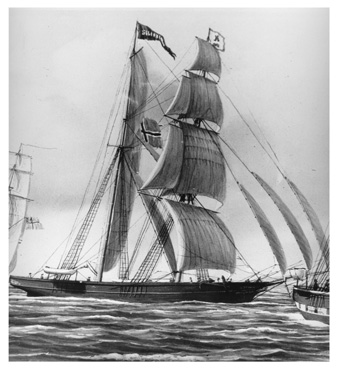
posted by Gary Gauer 18 February 2017
Note by Rosalie:
"My 3x-great grandfather, Rev. Johannes Andreas Johannessen Bomstad, was the mindekirken (dissenter) leader in Troms during the 1850-60's, who led the colony of Troms dissenters from Balsfjord area in 1862, sailing from Bergen to the Chicago, IL aboard the "Sleipner." Their voyage was noteworthy not only because he was leading a colony of Norwegians, Kvaen and Sami folk (who broke with the State Church) to the U.S. seeking religious freedom, but also because their voyage was the first trans-Atlantic voyage to an inland port (Chicago), without first landing somewhere along the St. Lawrence Seaway. There is a plaque on a bridge in Chicago noting their landing, however the actual records of the landing were destroyed in the great fire of Chicago (Mrs. O'Leary's cow did it!) There is a booklet in the Decorah library which mentions their voyage and landing, which has a photo of the port area, circa 1862. RS
Note by LaVonne:
Some explanation is needed before you begin to read this story. When they arrived the Norwegians still used their patronymic name Johannessen which soon was shortened to Johnson. They realized there were numerous Johnsons so they decided to use their place name from Norway. In the Norwegian language the “d” is silent for Bomstad so at first you will find records with their name spelled Bomsta, later most of the family added the “d” and used Bomstad. Some did not so this adds to the confusion. Johan Andreas was a famous leader and was written about in Norwegian books. These accounts are found at the end of this story. Johan was an amazing man to achieve so much during his lifetime. He raised a large family, farmed, traveled and wrote many books without the aid of a computer! LH
Johan Andreas Bomstad's ancestor Johannes Josephsson Örn, who was born in Muonio, Finland, migrated from the Tornedalen area to Lyngen in the late 1760's, and later migrated to Balsfjord, Troms, where he settled on a farm place called Bomstad. The farm place has a beautiful waterfall on the property. He and his wife were Kvaen, but several of the descendant family members were married to Sami folk, Swedish migrants and Troms Norwegians. Bomstad consists of a large area which is eventually filled as the children marry and need a farm to live on.
Johan Andreas was born August 23, 1821 to Johannes Abrahamsen and his wife Ane Johanna at the farm Bomstad, Balsfjord, Troms, Norway. His twin brother died shortly after birth. He married Ane Bergithe Johansdotter from Finland on November 5, 1843 in Tromsø, Norway. Nine children were born. Mary Henrietta, Johan Adolph, Henry J., Nils J., Christian, Johanne Kristine, Hanna Elisabeth, Eversine (Sina), and Anne Johanna. Two daughters died in Norway, Johanne Kristine (death date unknown) and Hanna Elizabeth, age 10 died shortly before they were to depart for America in 1862.
As a matter of note, "Reverend" Bomstad was never really ordained, having met Jacob Lammers while in the seminary school near Oslo, Norway during the 1850's. Rev. Lammers was the mindekirken leader in southern Norway, and influenced Rev. Bomstad to break with the State Church of Norway (because of the onerous (sic?) treatment and taxation of commoners by the clergy and the Norwegian government.) The mindekirker's believed that one did not need a member of the clergy to pray, and definitely not a cleric who was really a political appointee rather than a religious representative of the community.
Johan Andreas organized several groups from Balsfjord, Norway to come to America. After two years of preparation the first group left Balsfjord in 1862. They came aboard the sailing vessel, “Sleipner.” This was the first vessel to sail directly from a European port assigned to Chicago, Illinois. It was a small brig of 350 tons, estimated length of 125 feet. The “Sleipner” was considered to have had “deluxe” steerage in contrast to other sailing ships of the period. Instead of being confined in the bottom of the boat below the cargo, the “Sleipner” immigrants were given the first hold and on fine days, two hatches were opened to show the blue sky. Each family was allotted wide benches upon which they slept four abreast and under which they stowed small gear. They also were allowed to cook two meals a day on the double hearths. Their route took them by Hull, England, on to Quebec, Montreal, the Welland Canal, Detroit and finally arriving at Chicago on Sunday August 2. The voyage took 71 days. They refused to debark the ship on the Sabbath and waited until the next morning to leave the ship. A plaque on the State Street Bridge in Chicago commemorates the first arrival of the “Sleipner.” The Sleipner returned to America with more immigrants from north Norway in 1863, '64 & '65.


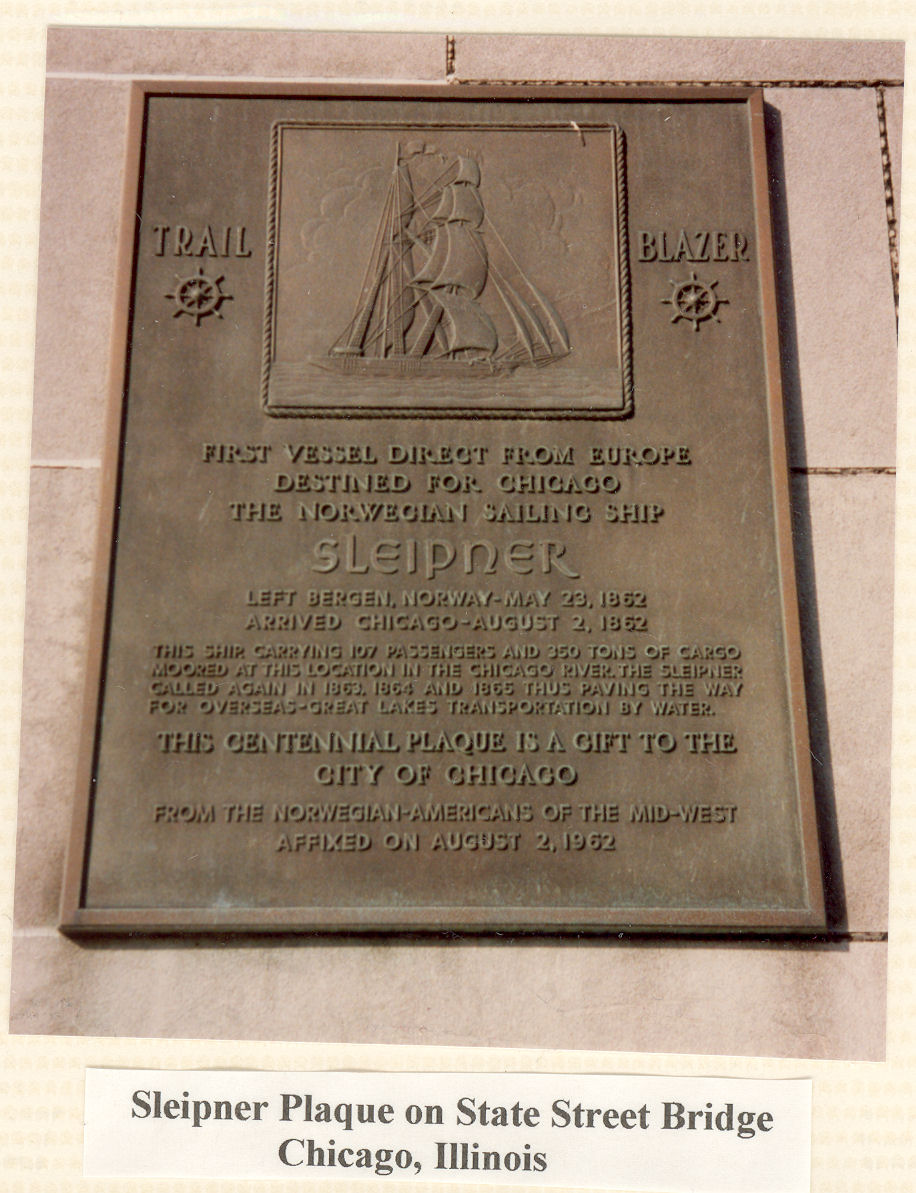
The party of immigrants bought provisions, gear, carts and oxen, and then headed west to find land to settle on. They came to Minnesota, just as the Sioux Indian uprising flared up and during the Civil War. They could only go as far as the Norwegian camp in St. Peter, Nicollet County, Minnesota. It was too dangerous to go any further. They remained there for more than a year with many other families from Tromsø, Norway. With no place to go, some of the young men in the party enlisted in the military service of their new country in the fall of 1863. Soldiers were needed for the end of the Civil War and the Indian Uprising. They served in the Second Regiment Minnesota Cavalry, Company “B.” Two sons of J.A.J. enlisted, Henrick Johanson Bomstad and John Adolph Johanson Bomstad. His brother, Albert Johannesson Bomstad enlisted, also. Elias Anderson’s son Andrew Eliason Anderson was with them as they went into the Lake Lillian area on some of their patrols. These young men were struck by the beauty of the area and on returning to St. Peter, gave glowing reports of what they considered an ideal location for a future home to the leader of the group, J.A.J. Bomstad. The old gentleman lost no time before investigation. Mounting his little grey mare, and with a gun on his shoulder he started alone across a wild country, finally reached Lake Lillian and found it to be everything his boys and brother had represented. He decided to locate at once. He staked a claim on land along the east shore of Lake Lillian in May 1864. He was the founder of the town of Lake Lillian (originally the East Lake Lillian Township), arriving one hour before another settler. After staking the claim, he returned to move the rest of his family to Lake Lillian in June and to lead the rest of the colony, where dozens of additional claims were staked by his sons and cousins and brothers, and by the other mindekirken colonists.
The first few months the Johan Andreas’ family lived in a dugout located close to where the M.E. Church stood. In the fall they had the log cabin finished and moved into it. In the same summer Elias Anderson, a close friend of Reverend Bomsta, located a claim adjoining and moved up with his family from Nicollet County in the fall. This was the beginning of the large settlements of Norwegians in East Lake Lillian and neighboring townships. The Reverend Bomstad may be properly regarded as the father of this settlement. Bomstad was influential in encouraging the settlement; it is interesting to note that of the settlers in the area (of East Lake Lillian, Fahlun, Lake Elizabeth, and Lake Lillian) about one-fourth were from northern Norway communities. They came from the inner fjord area of Balsfjord, the communities of Sørfjord and Ullsfjord, Karlsøy, Tromsøysund, and Tromsø.
The first settlers found that Lake Lillian was a favorite resort for friendly Indians, who continued to make their permanent homes within the reservations on the Minnesota River. It was no unusual sight to see the beach of the lake lined with Indian canoes in great numbers to do their fishing. Proof that the spot had been a favorite abiding place for the Indians in times past is evidenced by several Indian mounds found in the grove along the shore of the lake. A story is told of Mrs. J. A. J. Bomstad who had just finished churning when a few Indians appeared. She gave them buttermilk to drink. When they were ready to leave they saw a grindstone that they thought they could use. Indians had a practice that, if they needed something, they could take it from another Indian. This was not stealing and this theory was used in taking the grindstone. Mrs. Bomstad took after them with her broom. They left the grindstone and laughed among themselves at the little woman. The last group of Indians came to the Big Kandiyohi Lake area in 1910.
Johannes Andreas J. Bomstad bought land at the Receiver’s Office at Minneapolis, according to a receipt dated April 20, 1865. The land consisted of just over 64 acres near Lake Lillian, Kandiyohi County, purchased at $1.25 per acre, and totaling $80.25. He was naturalized at Willmar, Kandiyohi, Minnesota on September 21, 1871, as witnessed by his brother, Eliseus. J. Bomsta and his neighbor, Eric J. Larson. He was elected town supervisor in the first Lake Lillian Township election in 1872. Johan Andreas and his sons served on local government boards as supervisor, assessor, board chairman, justice and constable. Before a school was built for the community, classes were held at Johan Andreas and Ane Bomstad’s log cabin and they helped get the first school built in East Lake Lillian Township. He also formed a literary society. The residents worked together to build roads, schools, churches, creameries, stores, etc.
After his arrival in Kandiyohi County he wrote and published several books in which he set forth his version of the Christian religion, and also made three trips back to Norway in the interest of his church. His first trip back was in 1871. Some of his family members sent money with him to help out the Norwegian dissenter movement. The leader in spiritual matters in the early settlement naturally was Rev. Bomstad. Regular services were held in the school house of District No. 4 (later No. 40), which was located in the early days by the lake, near Rev. Bomstad's log cabin. No regular church records were kept or considered necessary. Until his death Rev. Bomstad continued to preach to those who remained faithful and to those who still profess to be members of the Apostolic Free church.
Johan A. J. Bomstad wrote tracts throughout his life, apparently commenting not only on religion but also on politics. While most were published in Norwegian, his An Epitome and Explanation of the Principal Doctrines of the Bible was printed in English in 1881. That same year he authored Bilbelns Forklarer, a religious work, and in 1886 he published Et Sandhedsvidne (A Witness of Truth); the latter was published in Norway, and listed his former home farm, Nordkjoselv, Balsfjord, Norway on the title page. Sometime before 1890 he published Den Politiske Reformven at Minneapolis. He continued preaching and leading his congregation well into his later years. He also continued lecturing in the immediate area. For example, in 1885 he delivered several lectures in just one week. The Willmar Argus, in its Norway Lake columns of October 15 and 22 noted: Reverend J.A. J. Bomsta, of Lake Lillian, delivered several lectures in four different school houses during the past week.
A booklet celebrating the Centennial of Lake Lillian's founding was published by the (then) Lake Lillian Crier Newspaper in May 1964. Copies of some of this material is on file at the Minnesota History Center.
Rev. Bomstad's daughter Sina (Johannesdatter) Bomstad was married as a teenaged girl (in an arranged marriage) to Rev. Bomstad's friend, Dr. Andreas Nielson (Andreas Nilssen), whom he met sometime during his stay in the Oslo area. Dr. Nielson (who was born in Hølonda, Melhus parish, Sør-Trøndelag) was attending medical school there. One of Sina and Dr. Nielson's sons, Joseph Borneman Nielson, married Rosalie’s Sami great grandmother, Bertha Kristina Susanna Larsdatter in Lake Lillian, MN (a few years after her emigration to the U.S. in about 1905.) Rev. J.A. J. Bomstad was her 3x great grandfather. His brother, Eliseus Bomsta was LaVonne’s 2x great grandfather.
From the Balsfjord Bygdebok it states: In 1803 Hans Nilsen Hauge, a great lay Norwegian Evangelist, visited Balsfjord to preach the word of God, which we know he did from a more free and popular point of view than the State church ministers of that period. Many years rolled by before there occurred any noteworthy religious awakening. Johan Andreas Johannessen, a Bomstad, was as far as it is known, the first layman from the community to start having religious meetings conducted by himself. This was about the year 1850. Despite the fact that he was unschooled, his preaching had such power of attraction that people from neighboring communities of Lyngen, Ullsfjord and Målselv came to hear him. It is certain this religious movement caused numerous withdrawals from the State Church and caused friction, unfriendly relations, and the splitting up of families. In 1856 they organized their own church and gave it the name of "The Free Apostolic Christian Church." Johan A. J. Bomstad was the first presiding Elder of that church until he emigrated in 1862.
Mindekirken Movement in Tromsø, Norway
According to the book Tromsø City History (Norwegian: Tromsø by Histori) written by Ytreberg (published in Norwegian), during the mid-19th century, Balsfjord became the religious home of a group of "mindekirken" or "freechurch dissenters" who split from the state church parish in Tromsø. The mindekirken movement in the Troms region was led by the seminary student, Johannes Andreas Johannessen Bomstad (born at Balsfjord on 23 August 1821), who split from the state church at the age of 28, under the leadership of the first Norwegian mindekirken movement leader, Rev. Lammers from Oslo. In 1856, Bomstad and his original followers established their own church which they called the "Free Apostolic Christian Church" in Balsfjord.
"Rev. Bomstad" and his followers were said to have struggled and protested against the Tromsø state church minister and the Troms Bishop's religious rulings, eventually leading to a riot in the town of Tromsø, when state-church members yelled at Bomstad and his fellow dissenters to "go back to Kautekino (Finland)."
In 1862, Bomstad led a group of "mindekirken colonists" to America, traveling first to Bergen, where they sailed in mid-May 1862 aboard the Sleipner, arriving at the inland port of Chicago, Illinois on 2 August 1862. Their voyage was also noteworthy as the first transatlantic voyage sailing directly from Europe to the port of Chicago (other previous transoceanic ships disembarked first at Quebec, Canada.) After arriving in Chicago, the mindekirken colonists traveled overland to the area of St. Peter, Minnesota, where they remained during the "Dakota War of 1862."
Lake Lillian
Rev. Bomstad left St. Peter traveling by mule to Kandiyohi County, Minnesota, where near the east bank of a lake (previously called "Lake Lillian"), he became the founding father of Lake Lillian, Minnesota in May 1864 (one hour ahead of the town's next settler, Mr. O. E. Hart (previously of New York.) After staking his original claim, a month later on 3 June 1864, Rev. Bomstad led the rest of the colonists from St. Peter to their new settlement at Lake Lillian, where they built dugout shelters to live in that first year (on the site later occupied by the First M.E. Methodist Church of Lake Lillian.) A few months later he and his family finished building and moved into their log cabin home.
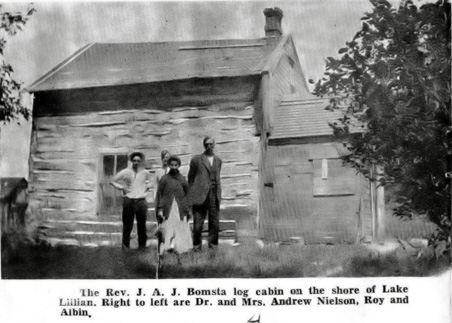
A nice write up about Rev. Johan A. J. Bomstad can be found in the Balsfjord and Malangen History Book, Volume Two published in 1991. People living in Balsfjord today may not know where New York or Chicago can be found on a map but they know where Lake Lillian is! LH
Johan Andreas Johannessen Bomsta was born in the year 1821 at Balsfjord, Tromsø, Norway. He was well educated in the common branches. He was converted at the age of twenty-eight, and became active with the Rev. Lammers in organizing the Apostolic Free Church which was also known as Lammers Free Church, the first dissenting church organization in Norway. He became a forceful preacher and was very popular among his people, among whom he was commonly known as "Bishop Bomsta" although there was no such official in the church. After devoting twelve or thirteen years to the religious cause in Norway, he decided that the great free republic of the West was the place to find a permanent home. He emigrated with his family and a party of friends and neighbors to America. They left Bergen, Norway on May 22 aboard the ship “Sleipner” and arrived in Chicago on August 2, 1862. The group first located in Nicollet County, near St. Peter. Hardly had they become comfortably domiciled here when the great Indian Uprising of that year occurred and they were obliged to abandon their homes and seek safety in St. Peter. Two of his sons Johan Adolph and Henrick and his brother Albert enlisted in Company B, of the Second Reg. Minn. Cavalry at St. Peter in the fall of 1863.
After his arrival in Kandiyohi he wrote and caused to be printed several books which he set forth his version of Christian religion, and made three trips to Norway in the interest of his church. His first return to Norway was 1871. The photographic likeness reproduced here with was taken that year.
Reverend Bomsta married Anna Brita Johanson in 1843. She was born in Finland. She died at Lake Lillian in 1901, at the age of over ninety two years, Reverend Bomsta died June 18, 1896, his age being given as seventy five years, nine months ad twenty three days.
They brought seven children to America; Mary, Mrs. A.P. Quist, John Adolph, Henry J., Nels J., Christian, Sina, now Mrs. Dr. Andrew Nielson, who lives on the old homestead, and Anna J. Bomsta. All of the sons are dead. Two children died in Norway.
There were four brothers of the Bomsta family who came to America. Johan A.J., Hendrick, Eliseus and Albert. Hendrick was the first to emigrate and settled in Chicago. The other three became early settlers in the Lake Lillian community,
Willmar Tribune – August 4, 1896
–transcribed by LaVonne Bomsta Hookom
The following is a brief sketch of the life and career of the late Rev. Johan A. J. Bomstad who died at his home on the east side of Lake Lillian on the 18th day of June, 1896, at the age of 74 years, 10 months and 22 days.
On his father’s homestead in Balsfjord, Norway the deceased was born the 26th of August, 1821, and resided there until his departure for this country. In early boy-hood days he showed a marked interest in all religious matters and was a most devout member of the state church of Norway until the 28th day of April, 1856 when he withdrew and started his own, Free Apostolisk church, now so well known in his native country and which has a membership of several thousand scattered throughout the United States.
He landed with his family in this county in the spring of ’62 and first settled in the neighborhood of St. Peter where he remained for two years and then moved to Lake Lillian, where he held the distinction of being the first settler.
He and four sons then entered extensively into the farming business, and the success of these energetic men a passer by will quickly observe.
For 30 years he filled the pulpit and to the universal satisfaction to all hearers explained the love and keeping power of his Friend and Savior. During his life he caused the publication of several books, all of which have a large circulation amongst the people in this and foreign countries.
As one who knows, let me state, a loving father, a kind and forgiving friend, and worthy citizen has been taken away from us, and the old and familiar lines, can truthfully be quoted.
“A precious one from us has gone;
A voice we loved is stilled.
A place is vacant in our home,
Which never can be filled.”
He died on the 18th from a complication of diseases and on the 20th of June was laid to rest in the Lake Lillian cemetery where a large number of friends and relatives had gathered to pay their last respects.
To mourning relatives and friends; Console yourself in the knowledge that he has gone to the place where no sorrow or trouble can enter, but where he with others who have preceded him, live in joy and splendor forever and ever. Let us all hope, and live so that some day we may meet him and other dear ones now gone there.
H.E. Dreyer
(I have not seen an actual obituary for him. This does not give any family data - LJH)
Johan Andreas and his wife are buried in the Pioneers Union Cemetery north of Lake Lillian in unmarked graves.


Rev. home place -
J.A.J. Bomstad's grandson Adolf was born in the cabin near the barn.
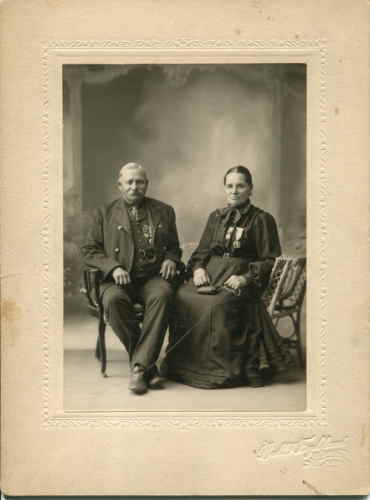
Mary and Andrew Quist - Mary is the oldest daughter

Sina is the youngest daughter married to Dr. Andrew Nielsen
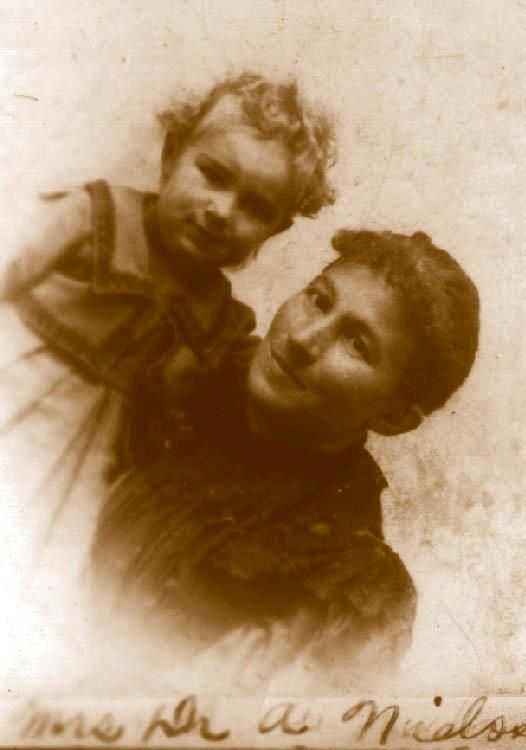
Sina and her son Guy
Bomsta Men
J.A.J. Grandsons, sons of Henry J. and Anna Bomstad-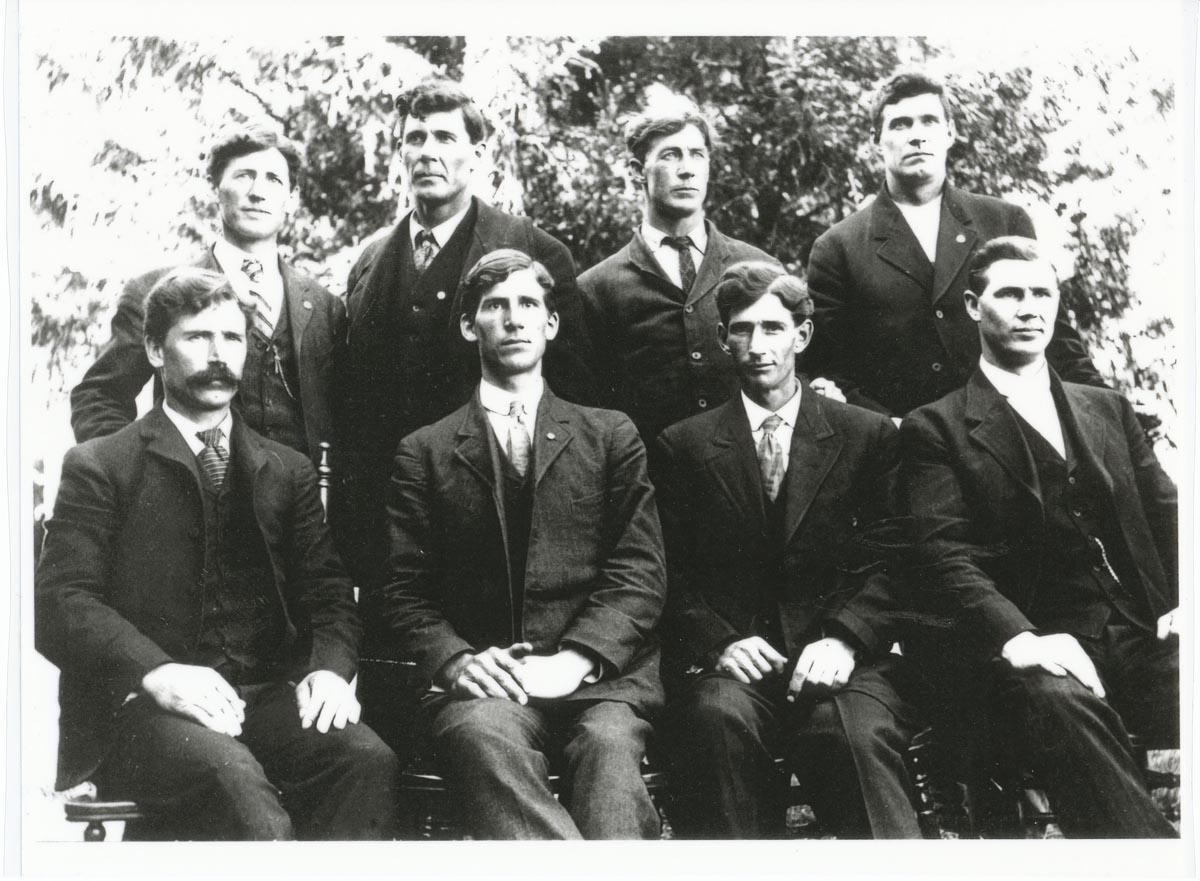
-BR-Andy 1875-1951; Henry W. 1870-1932; Bennie 1878-1957; John L. 1869-1937;
FR - Adolph 1867-1945; Axel 1882-1932; Richard 1884-1969; Alfred 1880-1955 -
They all used the surname Bomstad except Alfred who kept Bomsta.
